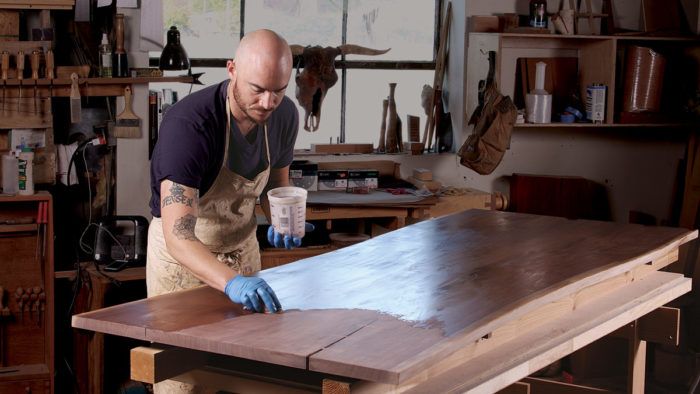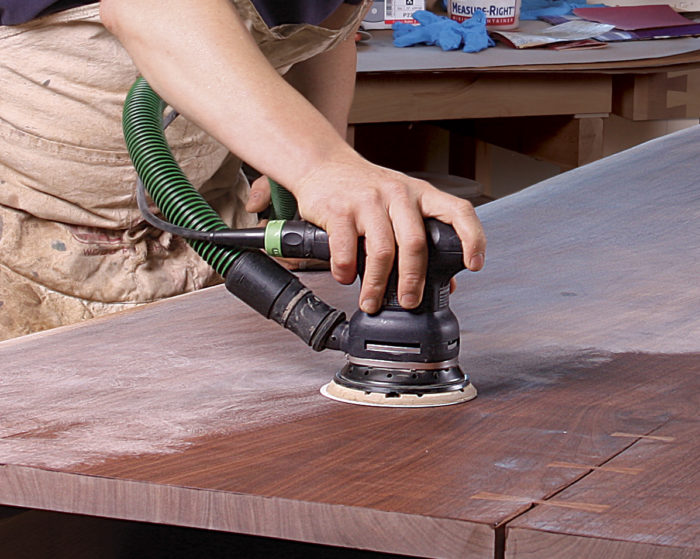Osmo Oil: Durable, Easy to Use, and Nontoxic
Marcus Soto's technique starts with a slurry of Polyx-Oil sanding in to fill the grain. After that he applies it like a traditional oil finish and buffs it out.

My business partner and I run a sustainable lumber company and make custom furniture from these trees (see my trestle table on pp. 30–37). In the spirit of how we harvest and use the wood, we want our finish to be easy to use, durable, non-toxic, and easy on the environment. Osmo Polyx-Oil is all those things. Made from natural vegetable oils and waxes, it does not off-gas or smell bad. It’s durable, easy to apply, and easy to repair. The secret to success with this oil is filling the pores first.
Start the surface prep by sanding up to at least 220 grit. At 180 grit, I raise the grain with a damp cloth and then continue sanding. Next, make a slurry to be used as the filler. Add a thin coat of Polyx-Oil with a cotton rag. Then take wet-or-dry sandpaper of 220 or 320 grit and sand the finish into the wood. The slurry should have a puttylike consistency. After you produce the slurry, work it into the grain. Ball up a rag as if you were doing a French polish. Start at one end, working your way down in overlapping circles. Let the filler dry overnight, then sand it down with 150-grit paper. If there is any open grain, sand to 220 grit and repeat the entire process until there is no more open grain; twice is usually enough. Sand to the finished grit and you are ready to add the final coats of Polyx-Oil.
Polyx-Oil is applied like a traditional oil finish: Put it on, let it penetrate, and wipe it off. Allow at least eight hours for the finish to dry. For a tabletop I usually add three coats. On bases, I add two coats following the same process. Between coats I scuff-sand with a very fine abrasive pad. You can also use very fine sandpaper, 320 grit or above. After the finish has cured, I use a clean cloth to give it a thorough buffing out.
Fill the Grain
Filling open grain with the slurry will provide added protection by decreasing the chances of moisture building up in any of the open capillaries of the wood. This makes the finish suitable for tabletops.


Then Build the Finish



Marcus Soto is design and production partner at New York Heartwoods in Kingston, N.Y., and owner of Sojen Design.
From Fine Woodworking #262
 For the full article, download the PDF below:
For the full article, download the PDF below:
Fine Woodworking Recommended Products


Odie's Oil









Comments
The article is vague about how to create the slurry. Is it just a mix of the Polyx-Oil and water, or are there other ingredients? If the Polyx-Oil is so thick that you can make a slurry from it, when you put the second coat on, do you dilute it further?
I've been using, carrying and selling Osmo online extensively and I can't vouch for mixing water with it... likely not the greatest idea actually because it consists of 3 natural oils, 2 natural waxes, and white spirits as a solvent. If anything I would use TopOil which is a lighter consistency than PolyX-Oil and certified food safe for that matter. Or I've heard of some people "water popping" so the grain of the wood is open a little more (also not really necessary...). Maybe you're trying to apply it too thickly and find the need to thin it? This finish is meant to be a 2 coat finish and applied very very very thinly because it builds with each coat. The oils are meant to soak into the wood and give it that permanent wet look, the solvent evaporates and the waxes protect the surface. If you still find the need to thin the PolyX-Oil then I'd instead use a little more solvent - or just use it as it is intended because the Germans have developed these products over the course of 30-40 years. If anyone would like to know more or would like to try any Osmo products please contact me: [email protected]
Further to my comment I noticed the sanding grits in the article. You're actually only suppose to sand to 150, maybe 180 for figured woods. Flooring guys who use the PolyX-Oil only sand to 120. The reason is that you are closing the grain and pores of the wood when sanding to higher grits. So, if you sand up to 150 only and don't skip grits ie: 60/80/100/120/150 you leave the pores open enough to accept the oils and waxes. The article title should almost be Osmo High Solid Oil & Wax Hybrid Finishes.
The article never says one word about WATER....in fact the only thing it mentions that would lead someone in that directions is the mention of WET/Dry Sandpaper. It never says to use water though...the WET is the Osmo itself sanded wet into the slurry which is then padded into the pores
Very happy to see an article about Osmo Polyx-Oil and I'm a big fan, but I don't agree with the amount of product used; it says, "If the finish tacks up, add more and redistribute it", and in my experience if the finish tacks up, you've applied way too much! If you think you've applied too much, you have. A little goes a very long way, where you can do a 96"x40" top with just ~2oz per coat.
I've never tried the slurry technique, but everyone has their own finishing schedule! I prefer to buff the product in at a low speed with a white 3m 'cleansing' pad, let it soak, rub out excess, then buff it 'dry' with another white pad. With this technique you can achieve an incredible satin sheen!
Like Worthdoingwell, I have been using, carrying and selling OSMO for a very long time. I interact with many woodworkers educating them and discussing their technique. Marcus's technique of creating a slurry is fine but really only needs to be done with open grain wood such as walnut. I do not believe he is mixing water but just using a wet/dry sandpaper as we all know, oil and water do not mix. I recommend using a white scotch bright pad for the slurry application but do not recommend sanding between coats. You would run the risk of creating a white power from the two waxes that would then be in your finish.He also seems to be taking his projects to a higher grit than we like to see. 180 is as high as I would go. This finish should be Two VERY THIN coats only - wipe on/wipe off and repeat. Or - best advice, don't leave it on top and don't burn down the shop. (dispose of rages properly) If you need advice email sales (at) worldclasssupply(dot)com
Any thoughts about using this for an office desk top made of a cherry slab? Would the durability be a concern? I’ve never used Osmo before and want to stay away from polyurethane’s plastic look. Thanks!
If you stain the wood; should you put a light layer of shellac on before applying the Osmo?
Log in or create an account to post a comment.
Sign up Log in